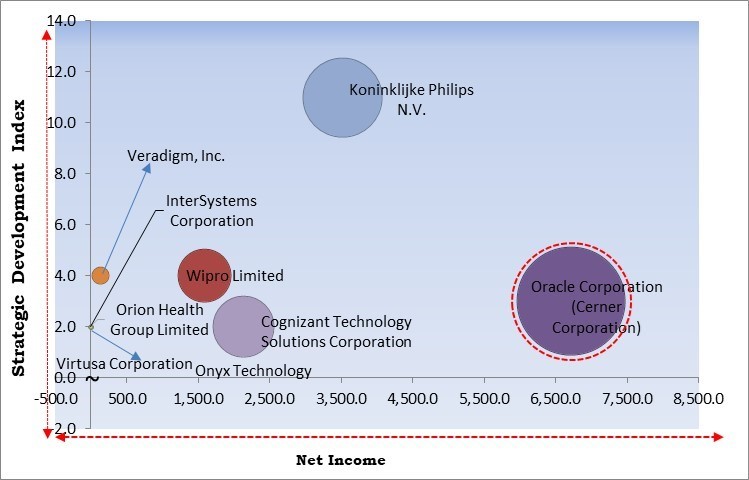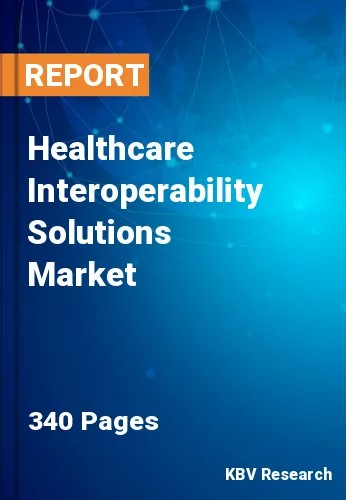The Global Healthcare Interoperability Solutions Market size is expected to reach $7.5 billion by 2029, rising at a market growth of 12.9% CAGR during the forecast period.
Interoperability in healthcare belongs to the timely & secure integration, access, and utilization of electronic healthcare data to optimize the health results of people and groups. Interoperability and data sharing are likely to become increasingly important for providing good healthcare as populations throughout the world age and people live longer. The ability of multiple systems to exchange health data and use it after receiving it is known as interoperability.

When using offline mode, sharing large amounts of data is challenging. As a result, the acceptance of healthcare interoperability solutions within the healthcare industry is crucial since they make it simple to share and store massive data, which fuels the market for healthcare interoperability solutions. Also, the market need for healthcare interoperability solutions has increased due to the government's adoption of different healthcare reforms.
Data exchange throughout the value chain and integrating all medical devices are essential to the future of healthcare. With data-driven technology, the healthcare industry must transition from its current curative approach to a completely preventive care model. The best way healthcare systems can enhance the patient experience is by updating systems to incorporate the newest technologies and enhancing security. In the upcoming years, system interoperability is expected to enhance the state of healthcare as a whole.
Healthcare interoperability solutions help in understanding the efficacy of the pharmaceuticals produced and the capability of the healthcare system to distribute these treatments to patients in need. Knowledge that promotes public health is crucial. As a result, it is anticipated that the market for healthcare interoperability solutions will grow steadily in the upcoming years. As the need for high-quality healthcare increases, the government promotes information interoperability through initiatives and advertising. It is predicted that the market will be supported by the government's and public organizations' efforts.
Accurate patient data, electronic patient records, interoperability, and cyber security remain the main concern for healthcare organizations. Since healthcare organizations have quickly shifted to online settings and remote care, E-health played a big part in shifting healthcare services from products to services, which raised market demand. Furthermore, the population's growing interest in receiving healthcare online through gadgets and applications and the speedy advancement of home healthcare delivery technologies further helped the market grow. Thus, the healthcare interoperability solutions market has witnessed a positive impact due to the outspread of the COVID-19 pandemic.
Interoperability can lower waste and total costs while enhancing patient safety by lowering radiation or invasive procedure exposure. The greater access to pertinent and longitudinal clinical data at the time of service made possible by interoperability may enhance clinical treatment. Fast Healthcare Interoperability Resources (FHIR), an open-source standards framework for healthcare data, is based on the earlier HL7 standards framework. FHIR was created to make it easier to move healthcare data between systems. The emergence of such new technologies is estimated to support the market's growth in the upcoming years.
Software interoperability is defined as the capacity of various solutions to communicate with one another in a straightforward and unrestricted manner. Data can be sent in real time between interoperable systems without requiring expert IT assistance or code running in the background. It might be anything as straightforward as a CRM system that interfaces highly with automation software to establish a data flow between sales and marketing. Alternatively, the team could set up a comprehensive tech stack of interconnected apps that can send data to streamline operations. These factors are anticipated to support the expansion of the healthcare interoperability solutions market.
Every department in a hospital facility now has its own IT system, from emergency services to laboratories, radiology, and patient rooms, illustrating how big and complex the healthcare IT landscape has become. Hospitals globally are under pressure to improve efficiency & patient outcomes due to the enormous amount of healthcare data they produce every day. They are limited in what they can do with the data they gather by the development of technologically advanced medical equipment, secretive troves of unstructured data, and incompatibility with other systems. As a result of this, the increased complexity may hinder the growth of the healthcare interoperability solutions market.
By component, the healthcare interoperability solutions market is segmented into software solutions and services. In 2022, the services segment held the highest revenue share in the healthcare interoperability solutions market. This can be attributable to the paradigm change toward cloud computing & cloud-based platforms to lower operating expenses for better & faster business application & process performance. Other factors that contribute to the segment's growth include recurrent purchases of services like software maintenance and updates.

Based on level of interoperability, the healthcare interoperability solutions market is bifurcated into foundational interoperability, structural interoperability, and semantic interoperability. The semantic interoperability segment recorded a remarkable revenue share in the healthcare interoperability solutions market in 2022. The most reliable interoperability method now on the market, semantic interoperability, allows for the transmission of information between more than two systems. Via possibly dissimilar EHR and other systems, semantic interoperability facilitates the electronic interchange of patient data among authorized parties and providers to increase healthcare delivery's efficiency, effectiveness, and safety.
On the basis of end users, the healthcare interoperability solutions market is categorized into healthcare providers, healthcare payers and pharmacies. In 2022, the healthcare providers segment dominated the healthcare interoperability solutions market. Increased patient volume, the need to contain increasing healthcare expenses, and government mandates are factors contributing to the growth of this market segment. This element is anticipated to accelerate the market's growth for healthcare interoperability solutions.
| Report Attribute | Details |
|---|---|
| Market size value in 2022 | USD 3.2 Billion |
| Market size forecast in 2029 | USD 7.5 Billion |
| Base Year | 2022 |
| Historical Period | 2019 to 2021 |
| Forecast Period | 2023 to 2029 |
| Revenue Growth Rate | CAGR of 12.9% from 2023 to 2029 |
| Number of Pages | 340 |
| Number of Table | 563 |
| Report coverage | Market Trends, Revenue Estimation and Forecast, Segmentation Analysis, Regional and Country Breakdown, Competitive Landscape, Companies Strategic Developments, Company Profiling |
| Segments covered | level of Interoperability, Type, End User, Region |
| Country scope | US, Canada, Mexico, Germany, UK, France, Russia, Spain, Italy, China, Japan, India, South Korea, Singapore, Malaysia, Brazil, Argentina, UAE, Saudi Arabia, South Africa, Nigeria |
| Growth Drivers |
|
| Restraints |
|
Region wise, the healthcare interoperability solutions market is analyzed across North America, Europe, Asia Pacific and LAMEA. In 2022, the North America region led the healthcare interoperability solutions market by generating the largest revenue share. Some key drivers that influence the acceptance of interoperability solutions in this region include the increased demand for effective healthcare services, the need to reduce healthcare costs, and the successful implementation of EHR by healthcare organizations.
Free Valuable Insights: Global Healthcare Interoperability Solutions Market size to reach USD 7.5 Billion by 2029

The major strategies followed by the market participants are Partnerships. Based on the Analysis presented in the Cardinal matrix; Oracle Corporation (Cerner Corporation) is the forerunner in the Healthcare Interoperability Solutions Market. Companies such as Koninklijke Philips N.V., Wipro Limited, and Veradigm, Inc. are some of the key innovators in Healthcare Interoperability Solutions Market.
The market research report covers the analysis of key stakeholders of the market. Key companies profiled in the report include Oracle Corporation (Cerner Corporation), Epic Systems Corporation, Virtusa Corporation, Wipro Limited, Koninklijke Philips N.V., Veradigm, Inc., Cognizant Technology Solutions Corporation, Onyx technology LLC, Orion Health Group Limited, and InterSystems Corporation.
By End User
By level of Interoperability
By Type
By Geography
The Market size is projected to reach USD 7.5 billion by 2029.
Enhancements in software technology to support real time data exchange are driving the Market in coming years, however, Rising complexity as a result of lack of consistent data restraints the growth of the Market.
Oracle Corporation (Cerner Corporation), Epic Systems Corporation, Virtusa Corporation, Wipro Limited, Koninklijke Philips N.V., Veradigm, Inc., Cognizant Technology Solutions Corporation, Onyx technology LLC, Orion Health Group Limited, and InterSystems Corporation.
The Structural segment acquired maximum revenue share in the Global Healthcare Interoperability Solutions Market by level of Interoperability in 2022 thereby, achieving a market value of $3.3 billion by 2029.
The North America market dominated the Market by Region in 2022, and would continue to be a dominant market till 2029; thereby, achieving a market value of $2.9 billion by 2029.
Our team of dedicated experts can provide you with attractive expansion opportunities for your business.

